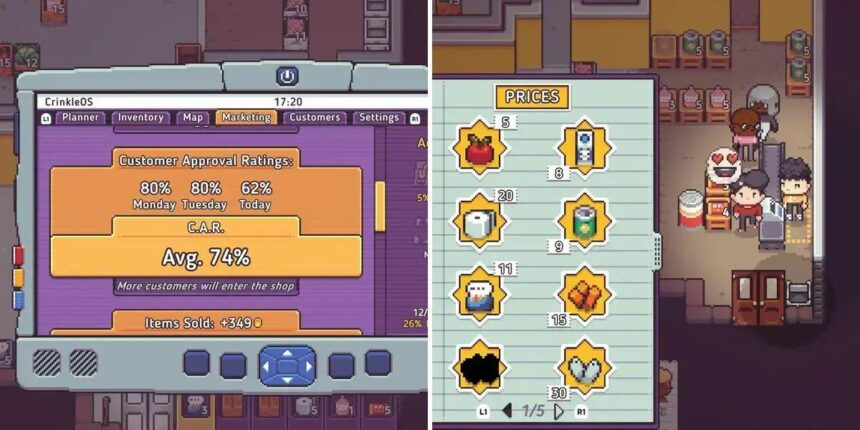Learning from customer feedback is essential for improving business operations. It involves collecting feedback through surveys and social media to understand customer preferences. By effectively analyzing this feedback, businesses can make informed changes that enhance the customer experience. Engaging customers in the feedback process shows that their opinions are valued, fostering loyalty. Implementing changes based on feedback and communicating these adjustments back to customers ensures ongoing improvements, which can lead to higher satisfaction and repeat business.
In the game Customer Approval Rating, achieving high scores is a challenge but feasible. Discover impactful strategies to elevate your game performance and delight your customers!
How Customer Approval Rating is Measured
Measuring the Customer Approval Rating is vital for any business aiming to improve. It helps you understand how customers feel about your services or goods. So, how is this rating measured?
Surveys and Feedback Forms
One common way to gauge customer approval is through surveys. You can send them out via email or ask them directly in-store. Keep questions short and straightforward. For example, ask how satisfied they are with their purchase. This gives you useful insights.
Rating Systems
Many businesses use a rating system, where customers can rate their experience from one to five stars. This makes it easy to see trends in customer satisfaction at a glance.
Online Reviews
Checking online reviews is another method. Reviews on platforms like Yelp or Google help you know what customers think. High ratings indicate approval, while low ones signal problems.
Social Media Mentions
Social media is a great tool for measuring customer sentiment. Look for mentions of your brand on platforms like Twitter and Facebook. Positive comments can boost your rating.
Customer Retention Rates
How many customers return is also a sign of approval. High retention rates often mean satisfied customers. If they keep coming back, it shows you’re doing things right.
Net Promoter Score (NPS)
The Net Promoter Score is another method. It measures the likelihood of customers recommending your business to others. A high NPS is a good indicator of customer satisfaction.
In conclusion, use a mix of these methods to get a clear picture of your Customer Approval Rating. This helps in making informed decisions to enhance your business.
Keeping Your Stock Full: A Priority
Keeping your stock full is crucial for a successful business. When customers visit your store, they expect to find what they need. An empty shelf can lead to missed sales. So, how can you ensure your stock is always full?
Regular Inventory Checks
Conduct regular inventory checks to know what’s running low. This helps you stay ahead. You can set reminders to check stock weekly or monthly.
Use Inventory Management Software
Invest in inventory management software. This tool can track stock levels automatically. It alerts you when items are low, making restocking easier.
Understand Customer Demand
Pay attention to what your customers want. Track which products sell quickly. Adjust your stock based on these trends to keep up with customer needs.
Establish Reliable Suppliers
Build strong relationships with your suppliers. Having reliable suppliers ensures quick restocks. This minimizes the chances of running out of popular items.
Plan for Seasonal Changes
Anticipate seasonal changes in demand. Stock up on holiday items well in advance. This avoids last-minute rushes and ensures you meet customer expectations.
Train Your Staff
Make sure your staff knows the importance of keeping stock full. They can help identify when items are running low. Encourage them to communicate stock issues quickly.
By prioritizing stock management, you improve customer satisfaction. Happy customers are more likely to return for future purchases.
Effective Cash Register Management
Effective cash register management is key for any retail business. A well-managed cash register helps keep sales organized and improves customer satisfaction. So, what are some tips for managing your cash register effectively?
Train Your Cashiers
Start by training your cashiers well. They should know how to handle transactions smoothly. Provide them with clear instructions on using the cash register and processing payments.
Keep Track of Sales
Regularly track sales from the cash register. This gives you insights into your business performance. Use the sales data to determine popular items and times of day.
Handle Cash Accurately
Ensure cash is counted accurately at the beginning and end of each shift. This helps prevent mistakes and theft. A simple count can save you a lot of trouble later.
Use a Modern POS System
Consider using a modern point-of-sale (POS) system. These systems make managing sales easier. They can track inventory and generate reports automatically.
Keep the Register Organized
Always keep the cash drawer organized. Have separate slots for bills and coins. This makes it easier for cashiers to find the right change quickly.
Monitor Customer Transactions
Watch out for unusual transactions. Keeping an eye on your cash register helps catch errors or any suspicious activity. If something seems off, investigate right away.
By following these tips for effective cash register management, you can improve efficiency and customer satisfaction in your store.
The Importance of Cleanliness in the Store
Cleanliness in the store is essential for a positive shopping experience. A tidy environment makes customers feel comfortable and welcome. So, why is cleanliness so important?
First Impressions Matter
When customers walk into a clean store, they notice right away. A clean space invites them to explore. If the store is messy, they might leave and go elsewhere.
Health and Safety
Keeping your store clean helps promote health and safety. Regularly cleaning surfaces reduces germs and illnesses. This is especially important in high-traffic areas.
Enhanced Customer Experience
A clean store creates a pleasant shopping experience. Customers can easily find what they need. This often leads to longer visits and increased sales.
Improved Brand Image
Maintaining cleanliness reflects well on your brand. It shows that you care about your customers and products. A good reputation can bring in more customers over time.
Encouraging Repeat Business
When customers have a positive experience, they’re more likely to return. A clean environment encourages repeat business. Happy customers will spread the word about their experience.
Employee Morale
A clean store also benefits employees. They feel more motivated working in a clean environment. This can lead to better customer service and increased productivity.
By understanding the importance of cleanliness in the store, you can create a better atmosphere for customers and staff alike.
How to Attract More Customers
Attracting more customers is key to growing your business. There are several effective strategies you can use to draw people into your store.
Offer Promotions and Discounts
Start by offering special promotions or discounts. Everyone loves a good deal. Use signs in your store and on social media to promote these offers.
Enhance Your Online Presence
Make sure your business has a strong online presence. Use social media to share updates and engage with customers. Regular posts can keep your store on their radar.
Create an Inviting Atmosphere
The atmosphere in your store matters. Keep it clean and well-organized. Play soft music and use pleasant scents to make shopping enjoyable.
Host Events and Workshops
Hosting events can bring in new customers. Consider having product demonstrations or workshops. This can give people a reason to visit and discover more about your offerings.
Utilize Local Advertising
Don’t underestimate local advertising. Put up flyers or ads in community centers and local newspapers. This can help reach customers who live near your store.
Build Relationships with Customers
Good customer service can boost your reputation. Get to know your customers and their preferences. Personal relationships make people want to return.
By using these strategies, you can effectively attract more customers and grow your business.
Customer Engagement Strategies
Customer engagement is essential for building loyalty and increasing sales. Using effective strategies can help keep your customers connected and happy.
Personalize Communication
Start by personalizing your communication. Use your customers’ names in emails or messages. This small touch makes them feel valued and special.
Utilize Social Media
Engage on social media platforms. Share content that interests your audience. Ask questions and encourage comments to spark conversations.
Offer Loyalty Programs
Loyalty programs reward repeat customers. Offer discounts or points that can be redeemed later. This encourages them to return for more purchases.
Provide Excellent Customer Service
Great customer service goes a long way. Train your staff to be friendly and helpful. Quick responses to inquiries show customers you care.
Host Events or Workshops
Consider hosting events that relate to your business. Workshops or product demonstrations can attract interest. These events also allow customers to connect with your brand.
Gather Feedback Regularly
Ask for feedback often. Use surveys to learn what customers like or dislike. Acting on their input shows you value their opinions.
By applying these customer engagement strategies, you can create lasting relationships with your customers and boost your business success.
Boosting Inventory Through Trade Deals
Boosting your inventory through trade deals can significantly improve your business. Partnering with suppliers can help you stock up on popular items without straining your budget.
Understand Trade Deals
Trade deals are agreements between businesses to exchange goods or services. They can be incredibly beneficial, especially for retailers looking to expand their inventory.
Identify Key Suppliers
Start by identifying key suppliers you want to work with. Look for those who offer quality products at competitive prices. Building strong relationships with these suppliers can lead to better deals.
Negotiate Favorable Terms
Don’t be afraid to negotiate terms that benefit both parties. Discuss pricing, delivery times, and payment options. Negotiation can help you get the best value for your trade deals.
Stock Up on Popular Items
Use trade deals to stock up on items that sell quickly. This ensures you won’t run out of popular products, keeping your customers satisfied.
Monitor Inventory Levels
Regularly monitor your inventory levels to determine when it’s time to restock. Trade deals can help you maintain optimal stock without overextending your resources.
Promote New Products
When you receive new items through trade deals, promote them. Use social media and in-store signage to inform customers about these exciting additions.
Boosting your inventory through trade deals is an effective strategy. It can help keep your shelves full and your customers happy.
Learning from Customer Feedback
Learning from customer feedback is crucial for any business. It helps you understand what your customers like and what needs improvement.
Collecting Feedback Effectively
Start by collecting feedback through surveys and comment cards. You can also use online tools like social media and emails. Make sure to ask specific questions to get valuable insights.
Encourage Honest Opinions
Encourage customers to share their honest opinions. Let them know their feedback is valued. Sometimes offering small incentives, like discounts, can motivate them to respond.
Analyze the Data
Once you have feedback, analyze the data carefully. Look for common themes or issues. This will help you understand what customers appreciate or dislike about your products or services.
Act on the Feedback
Don’t just collect feedback; act on it. Make necessary changes based on what customers suggest. This shows you listen and care about their experience.
Communicate Changes
After implementing changes, communicate them back to your customers. Let them know you’ve made adjustments based on their feedback. This builds trust and loyalty.
Continuous Improvement
Learning from feedback should be an ongoing process. Regularly ask for customer input and keep making improvements. This helps you stay relevant and meet customer needs over time.
By learning from customer feedback, you can create a better shopping experience. Happy customers are likely to return and recommend your business to others.







